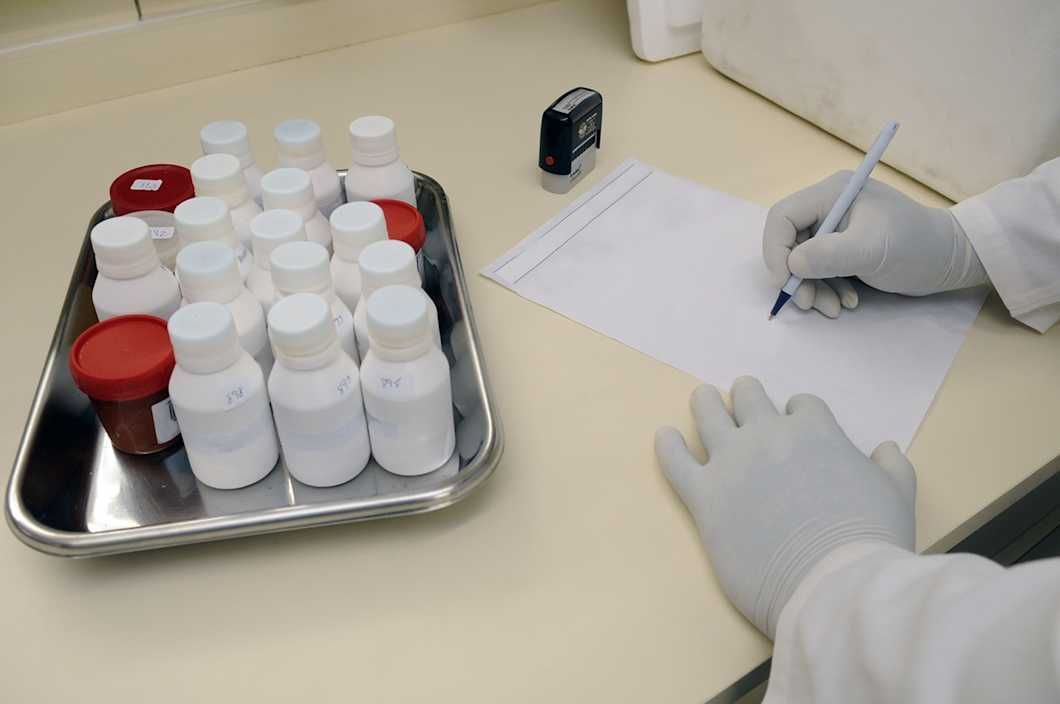Thermogravimetric analysis
Thermogravimetric analysis (TGA) is an analytical method for measuring the mass of a sample as a function of time and/or temperature. Weight changes can be detected with an accuracy of a fraction of a microgram, which makes the precise determination of the smallest changes in physical and chemical properties possible.

Some of our TGA services
Thermogravimetric analysis (TGA)
Identification of an unknown sample
Thermogravimetric analysis in a vacuum
Prices excluding VAT.
- Fast turnaround times
- Personal service from method experts
- Competitive prices
- Result accuracy guarantee
The basics of TGA analysis
Thermogravimetric analysis (TGA) is used to measure weight changes in the sample as a function of temperature and/or time. TGA is conducted in a carefully controlled thermal environment to achieve reliable and reproducible results.
TGA measurement has many applications in physical and chemical characterization because of its precise weight change detection capability. TGA is suitable for both heating and cooling the sample. The atmosphere can also be modified, with the most common options being inert or oxygen-rich.

Types of thermogravimetric analysis
The three types of thermogravimetry are isothermal/static, quasistatic, and dynamic thermogravimetry. Isothermal thermogravimetry is known as the traditional type of thermogravimetry. The sample is weighed multiple times per second, and the measured weight is recorded as a function of time at a constant temperature.
Quasistatic thermogravimetry includes sequential steps of temperature changes with separative isothermal stints. The idea is to allow the sample mass to reach a stable state before the next temperature change. In dynamic thermogravimetry, a continuous linear increase in temperature is used to heat the sample.
Applications of TGA
TGA is an ideal tool for material characterization, including the identification of unknown samples, as it provides both qualitative and quantitative data, only requires a small sample size, and can be performed on liquids and solids with very little sample preparation. TGA devices usually have a maximum sample weight of 1 gram and a maximum temperature of around 1,100 °C. When evaluating materials that are used in low-pressure applications, TGA can be performed in vacuum conditions.
TGA can be combined with other analytical techniques for an extended selection of uses. For example, evolved gas analysis (EGA) is possible when coupling a thermogravimetric analyzer with an MS, GC-MS, or FTIR analyzer. Also, if information on the effects of humidity is needed, dynamic vapor sorption (DVS) can be used to complement the results of a TGA measurement.
Need TGA measurements?
Measurlabs offers a wide selection of thermal analyses with methods including TGA, TMA, DSC, and dilatometry. Whether it’s just a dozen of samples or a large series, we offer competitive pricing and deliver reliable results quickly. Our experts are always just a message away, ready to guide you from test selection to result interpretation with clarity and care. Contact us through the form below to get a quote and start the discussion.
Suitable sample matrices
- Almost all kinds of liquids and solids with flammable and/or volatile properties
- Thermoplastics
- Thermosets
- Elastomers
- Composites
- Plastic films
- Fibers
- Coatings
- Paints
- Fuels
Ideal uses of TGA analysis
- Thermal stability
- Degradation
- Sublimation
- Vaporization
- Quantitation of volatile compounds and moisture
- Additive screening
- Evolved gas analysis (when coupled with i.e. MS or FTIR)
- Weight loss on drying
Ask for an offer
Fill in the form, and we'll reply in one business day.
Have questions or need help? Email us at info@measurlabs.com or call our sales team.
Frequently asked questions
Thermogravimetric analysis (TGA) is commonly used for material characterization and investigation of thermal properties.
TGA on its own is not the best method for a complete analysis of a sample, but when combined with methods like MS, GC-MS, FTIR, or EGA (evolved gas analysis), its possibilities expand a lot.
Thermogravimetric analysis is suitable for liquid and solid samples with flammable and/or volatile properties.
Measurlabs offers a variety of laboratory analyses for product developers and quality managers. We perform some of the analyses in our own lab, but mostly we outsource them to carefully selected partner laboratories. This way we can send each sample to the lab that is best suited for the purpose, and offer high-quality analyses with more than a thousand different methods to our clients.
When you contact us through our contact form or by email, one of our specialists will take ownership of your case and answer your query. You get an offer with all the necessary details about the analysis, and can send your samples to the indicated address. We will then take care of sending your samples to the correct laboratories and write a clear report on the results for you.
Samples are usually delivered to our laboratory via courier. Contact us for further details before sending samples.